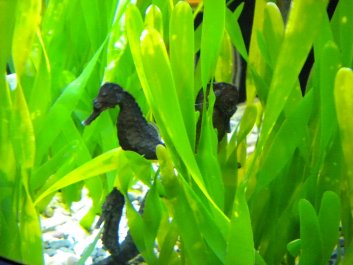Classification
 Hippocampus Kelloggi
Hippocampus Kelloggi
Domain- Eukaryota
Kingdom- Animalia
Phylum- Chordata
Class- Osteichthyes
Order-Gasterosteiformes
Family- Syngnathidae
Genus- Hippocampus
Species- Hippocampus Kelloggi (Great Seahorse)
Domain:Eukaryota
Hippocampus kelloggis
belong in the domain Eukarya,
which comes from the Latin roots, “eu” meaning “true”
and “karya” which means “nucleus.” Great seahorses are
classified under this domain because they have cells
which have true nuclei as well as membrane-bound
organelles.
Kingdom: Animalia
Hippocampus kelloggis are part of
the kingdom Animalia because they are
mulitcellular, heterotrophic, lacks a cell wall and they
are motile at some point in their lifecycle.
Phylum: Chordata
This organism is classified under
this phylum due to having these five main
characteristics in some point of their lifecycle: a
notochord, a tubular nerve chord, a pharyngeal pouches,
and a postanal tail. Great Seahorses are also part of
this group because they have segmented bodies, a coelom,
a complete digestive tract and three germ layers:
ectoderm, endoderm, and mesoderm. They are also
bilaterally symmetrical.
Class: Osteichthyes
Great seahorses are part of this
class because they are bony vertebrae and live in water.
Order: Gasteristeiformes
Hippocampus kelloggis are found in
this order since their bodies are covered in dermal
plates.
Family: Syngnathidae
Great seahorses belong to the
family Syngnathidae because they they have fused jaws.
Genus: Hippocampus
"Hippocampus" comes from the Ancient
Greek hippos meaning
"horse" and kampos meaning
“sea monster." A close relative to the Hippocampus
Kelloggi is the
Hippocampus ingens.
Species: Hippocampus kelloggi
The Hippocampus kelloggi is also
known as great seahorse.
This phylogenic tree illustrates
how the Hippocampus kelloggi is related to
several different species of seahorse. This tree is
based off of morphology as well as being labeled where
they can be found. The Hippocampus kelloggi is
classified by the size, location, as well as by its
coronet.
This phylogenic tree above
represents the one of the most basic ways to seperate
organisms into some pretty large groups of
classifications. The very first line represents the
ancestor of all organisms. Then it is divided into three
different domains, Bacteria, Achaea and Eukarya. The
Eukarya branches off into several different kingdoms.
The one that seahorses are classified under is Animalia.
Branching off of Animalia are several groups, where
seahorses are listed under the Chordates.
Continue to Habitat